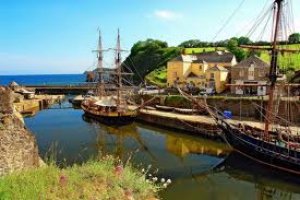


Alive with maritime history
Web: www.charlestownharbour.com
Web: www.visitcornwall.com/destinations/charlestown
St. Austell Bay Parish Council
Lying to the south east of the St. Austell clay area, the port of Charlestown, named after its developer Charles Rashleigh, was purpose built in the 1790's for the export of china clay, copper and tin. John Smeaton, the Eddystone Lighthouse engineer designed the port and it remains much the same today and is approached along the A3061 road.
The port of Charlestown was called West Polmear until 1790 when the population was only nine fishermen and their families. Charles Rashleigh saw that the expansion of the mining industry around West Polmear needed a harbour on the coast, he commenced building in 1791 using plans prepared by John Smeaton. It was decided that the inner dock would need to retain its water at low tide, which meant installing lock gates at the harbour entrance.
In addition to the harbour, Rashleigh built the Crinnis Gun Battery in 1793 to protect the village and the harbour, this was later used by the 'Huer' or look-out man. He would spot shoals of fish and alert the village fishermen, guiding the boats to the fish once they had put to sea. The name of the village was changed during 1799 in honour of Mr Charles Rashleigh and became Charles' town. Also in 1799 the first dock gates were erected.
On the 28th March 1881 the French vessel 'Cecile Caroline' of Croisec, left Charlestown bound for Nantes, France. She was wrecked later that night with all five crew lost.
Throughout the 19th century the little dock was packed with ships and the harbour-side sheds and warehouses thronged with complementary businesses: boat-building, rope-making, brickworks, lime burning, net houses, bark houses and pilchard curing.
China clay was discovered in the mid 18th century, by the chemist William Cookworthy, and by the 1850's, some 7,000 men, women and children were employed in the St. Austell clay district in the extraction, processing, transportation and export of the clay. No railway ever reached the village so all the china clay shipments reached the port by horse and cart, hence the very wide straight road leading down to the dock. A large amount of the clay was dried at the Charlestown clay kiln located just above the harbour.
By 1867 Charlestown had a respectable population. Sailors were also catered for at houses of ill repute known to this day as 'eleven doors'. Smuggling was at its peak between 1700 and 1850. Men known as 'free traders' supplied every item. They would drop brandy kegs over the side to be recovered later (this was known as 'saving the crop').
In 1971 the entrance to the dock was widened amd improved, with a new folding gate replacing the old wooden gates so that coasters up to 600 tons could now enter.
Charlestown harbour is still used by several local fisherman. The harbour itself was purchased by Square Sail Shipyard in 1993, a company that owns and sails a small fleet of tall ships. The ships are also used as training ships and can be chartered for sailing trips. The Grade II listed 18th century harbour was put up for sale at £4.4m in July 2012.
A Methodist Chapel was built in 1828 at Charlestown. This closed down in 1998 and is now derelict.
The church of St. Paul was built in 1851 but without a tower or spire, which were added in 1971.
The last china clay shipment from Charlestown was on the M.V 'Ellen' on 13th December 1999.
The author A L Rowse ashes are buried in the Campdowns Cemetery on Crinnis road.
Tony and Cherie Blair visited Charlestown as part of their holiday in August 2001.
The harbour is a popular film location and has been used for Dr Who (2011), Poldark (1975-1977), The Eagle Has landed (1976), The Three Musketeers (1993), Moll Flanders (1996), Rebecca (1996) Frenchman's Creek (1998), Mansfield Park (1998) and Wives and Daughters (1999).
Just along the coastpath to the east near Carlyon Bay is the National Coastwatch Institution lookout, giving amazing views up and down the coast.
The Charlestown Shipwreck and Heritage Museum is situated on the quay was sold due to the retirement of the owner. Also just up the hill from the harbour is Charlie's Coffee House which is located in the old Post Office.
The historic Cornish harbour has been sold in June 2018 for an undisclosed sum to Eden Project co-founder Sir Tim Smit.
On the 20th January 2023 all the hotel guests were evacuated from the 19th Century Pier House hotel after a fire broke out. Kevin Georgel, chief executive of St. Austell Brewery, which owns the hotel, said all staff and guests had been safely evacuated from the site. He said the fire was caused by an electrical fault.
Charles Rashleigh (1747-1823) lived at Duporth Manor, just outside the village and built the harbour, the lock gates and much of the village. In 1799 the village was renamed Charles's Town which became Charlestown.
The Charlestown Regatta - Mid July.
Charlestown Christmas Market - End November.
Boxing Day Swim - End December.
Fowey Par Pentewan St. Austell Porthpean The Eden Project
The Coastal Footpath Par Market Cornwall's China Clay Industry Wheal Martyn Museum